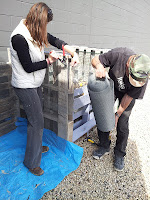In partnership with the Kompost Kids, a non-profit organization in Milwaukee, CORE/el Centro will offer signage and education on it's rooftop.
Last weekend a second compost bin was installed by volunteers, utilizing chicken wire, burlap bags and recycled pallets. The ingenuity of this design is that the bin door isn't attached directly to the sides of the bin, but is held on by pvc piping which is connected by metal anchors. See below for step by step photos of the process.
It is usually a good idea to build at least two compost bins so you can have one 'active' pile that you are adding to and another 'resting' pile that is breaking down (it will break down faster of you can turn out regularly.) Composting doesn't need to be done in a container, but having one helps the image and can deter critters from rummaging through your pile looking for dinner.
Here are the steps we took to build our community compost bins.
Step 1: Gather Materials
We were fortunate to receive burlap bags and pallets from donors. It helps to have large scale coffee roasters in town. You will also want chicken wire to line the bin, screws to hold it together and pvc pipe for the doors. You can also use up old paint by decorating the outside of the bin. We are planning to decorate ours more, we just ran out of time this day.
Step 2: Construct Frame
Because we already had one bin built we used the side of that bin to build our second bin. Using screws and an electric drill, fasten the sides together. Because we are on a rooftop with a gravel surface, we put down a tarp to be able to easily collect the finished compost. If you are building on your backyard you can put your compost right on the grass. It will become the most fertile place on your yard after a few years!
Step 3: Line the Inside of the Bin
We used a layer of chicken wire covered by burlap bags. The burlap will degrade over time, so in a few years we will need to replace the bags. You can also use landscape fabric instead off this double later process, but we were interested in spending the least amount of money!
Step 4: Attach the Door
Before attaching, line the door with the chicken wire and burlap and paint if you'd like.
Attach Pipe Straps to the sides of the frame, using the pipe as a measurement, to make sure they line up. Once attached at top and bottom, place the fourth pallet (door) in the frame to measure where to connect the pipe strap to the door.
The pvc pipe will then hold the door in place. When it is time to turn the compost, simply remove the pvc pipe and take off the then-freestanding pallet door.






























.jpg)

